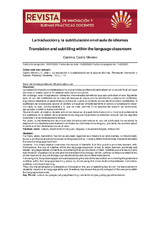Mostrar el registro sencillo del ítem
La traducción y la subtitulación en el aula de idiomas
| dc.contributor.author | Castro Moreno, Carolina | |
| dc.date.accessioned | 2023-06-01T10:13:23Z | |
| dc.date.available | 2023-06-01T10:13:23Z | |
| dc.date.issued | 2021 | |
| dc.identifier.issn | 2531-1336 | |
| dc.identifier.uri | http://hdl.handle.net/10396/25442 | |
| dc.description.abstract | La traducción ha sido considerada como una actividad profesional centrada en un producto final, en lugar de como un medio para un fin determinado: la comunicación. Sin embargo, esta interpretación olvida los innumerables beneficios que esta actividad ofrece. Siguiendo esto, el uso del subtitulado en la clase de lenguas es clave para la asimilación y mejora de contenidos lingüísticos mediante un aprendizaje que tiene en cuenta el contexto sociocultural de estos contenidos. El subtitulado es crucial para ayudar al cerebro a visualizar simultáneamente el sonido y la traducción de un concepto, lo que, contrariamente a lo que se cree, permite a los estudiantes adquirir las estructuras apropiadas y omitir la traducción literal. Siguiendo esto, el objetivo de este artículo es reevaluar el papel de la traducción y mostrar el potencial de los subtítulos en el ámbito de la enseñanza de lenguas mostrando su estrecha relación con los aspectos culturales y el aprendizaje de la lengua. Así pues, la implementación de una unidad didáctica centrada en el uso del subtitulado ha mostrado la mejora en los resultados del alumnado en todas las destrezas de la lengua y, por tanto, ha evidenciado el impacto positivo de este recurso en el aula. | es_ES |
| dc.description.abstract | For many years, translation has not usually been regarded as a means to an end, namely, communication, but as a professional activity focussed on the product; thus, it clearly differs from the task implemented within the second language classroom. However, this interpretation overlooks the myriad of benefits that this practice provides learners with. Furthermore, the use of subtitles within the language classroom is key to make learners assimilate and master language-related contents by considering their sociocultural context. Subtitles prove to be crucial to help the brain visualize the sound and the translation of a concept, which, contrary to what one might think, allows learners to acquire the appropriate structures and avoid literal translations. Following this, the present paper aims at reassessing the role of the translation and showing the potential of subtitles within the language teaching arena by showcasing the close relationship between translation, subtitles, culture and learning. Thus, the implementation of a didactic unit focused on the use of subtitling has shown the improvement in students’ results in all language skills and, therefore, has shown the positive impact of this resource within the language classroom. Key Words: culture, languages, language teaching, new technologies, pedagogical translation. | es_ES |
| dc.format.mimetype | application/pdf | es_ES |
| dc.language.iso | spa | es_ES |
| dc.publisher | UCOPress | es_ES |
| dc.rights | https://creativecommons.org/licenses/by-nc-nd/4.0/ | es_ES |
| dc.source | Revista de innovación y buenas prácticas docentes 10(1), 1-14 (2021) | es_ES |
| dc.subject | Cultura | es_ES |
| dc.subject | Enseñanza de lenguas | es_ES |
| dc.subject | Lenguas | es_ES |
| dc.subject | Nuevas tecnologías | es_ES |
| dc.subject | Traducción | es_ES |
| dc.subject | Culture | es_ES |
| dc.subject | Languages | es_ES |
| dc.subject | Language teaching | es_ES |
| dc.subject | New technologies | es_ES |
| dc.subject | Pedagogical translation | es_ES |
| dc.title | La traducción y la subtitulación en el aula de idiomas | es_ES |
| dc.title.alternative | Translation and subtitling within the language classroom | es_ES |
| dc.type | info:eu-repo/semantics/article | es_ES |
| dc.relation.publisherversion | http://www.uco.es/ucopress/ojs/index.php/ripadoc/index | es_ES |
| dc.rights.accessRights | info:eu-repo/semantics/openAccess | es_ES |

